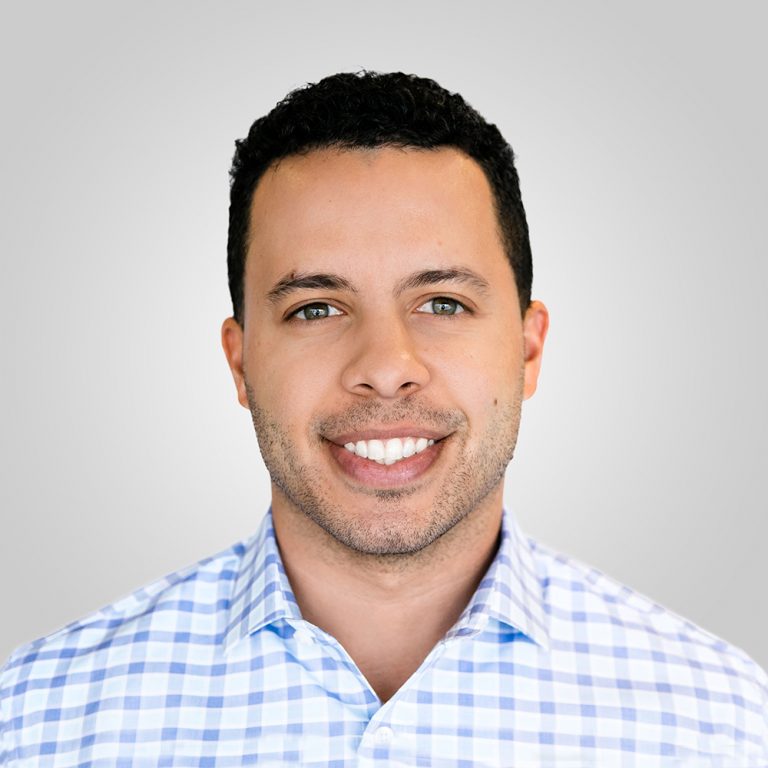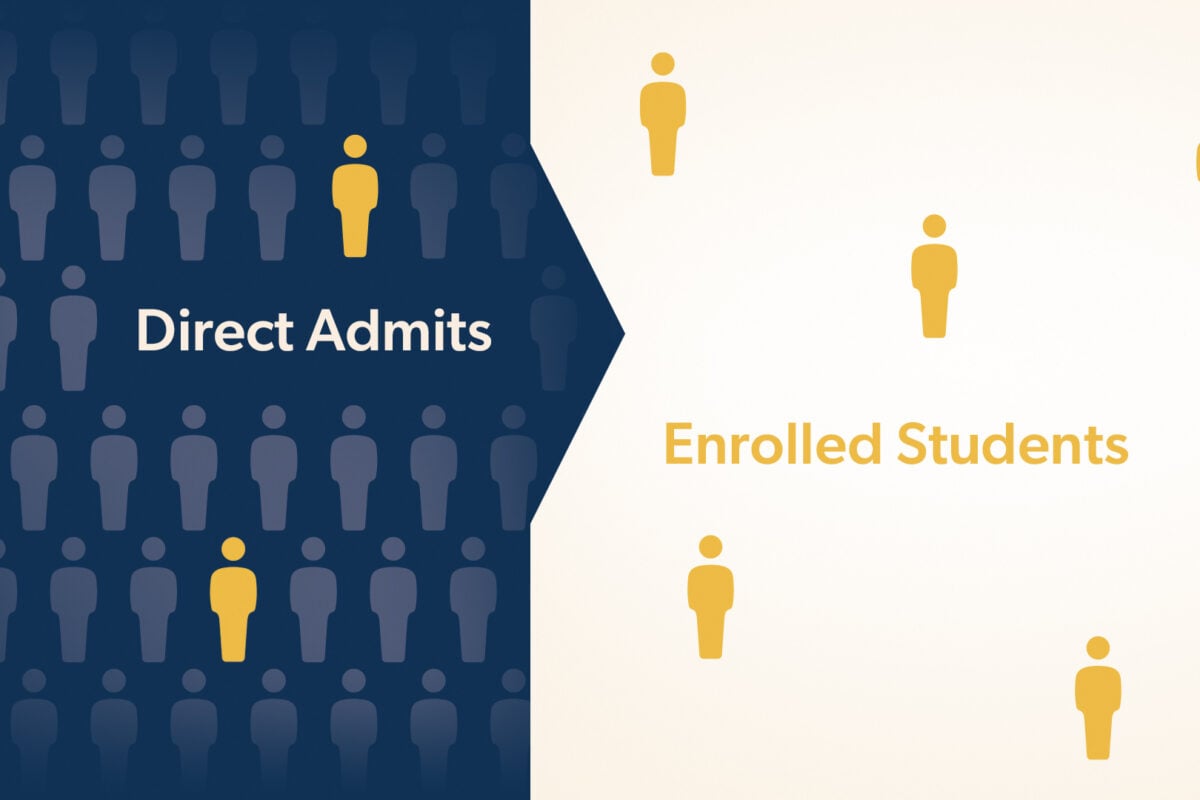A core driver in higher education enrollment marketing is paid media, spanning programs, audiences, platforms, and goals. This Innovating Enrollment Success episode dives into what’s working right now for a range of paid media budgets and the elements needed to engage real prospective students in real time.
Show Notes
Director of the Agency’s Paid Media presence in New York City Mike Collins joins Manager of Paid Media Cody Arnold to share their insights and expertise on multiple college and university campaign strategies to best engage prospective students.
This episode addresses:
- Ways to define and deliver continued paid media success
- Current trends generating meaningful enrollment results
- Different campaign goals/strategies for different audiences
- When and how to market content like the cost of college
- Evolving trends and technologies for new demographics
Learn More About Our Paid Media Capabilities
Transcript
Cathy Donovan [00:00:00]
Hello, and welcome to the Innovating Enrollment Success Podcast, where we explore the strategies and solutions that are best connecting prospective students to right-fit institutions right now. Competition in the enrollment marketing space has never been more intense with the enrollment cliff, distracted students, concerned parents, costs of college, and more.
Today, we’ll be chatting with two paid media experts about trends and tactics and how colleges and universities can get the most out of their paid media efforts to attract and enroll students.
I’m Cathy Donovan, Agency Marketing Director at Paskill, a higher education enrollment marketing firm that understands paid media strategies are always evolving and always a key part to effective enrollment marketing.
Director of Paid Media Mike Collins leads Paskill’s New York City practice. Before joining Paskill, Mike worked in Manhattan and focused on direct response campaigns and measurement solutions for a range of top consumer clients. He is a graduate of Auburn University with a degree in economics.
As Paid Media Manager Cody Arnold develops, analyzes, and optimizes campaigns. He receives constant praise from clients and was recognized by the agency in 2020 with a Rookie of the Year award. Cody is a graduate of Penn State with a degree in marketing.
Welcome Mike and Cody. Let’s get started.
So, Innovating Enrollment Success is obviously the name of this podcast and Paskill’s new tagline.
I’d love to hear from you what that might mean, especially in your everyday support of our college and university partners. Mike, will you start us off?
Mike Collins:
Absolutely and thank you. Really, when we look at it, the number one thing it means to me is adaptation, right? So, it’s an ever-changing landscape and what we’re dealing with on a daily basis. Last year is different than this year. Students are actually in a completely different mindset than they were one, two three, five, 10 years ago. So really being able to adapt to not only the audiences that we’re targeting, we’re going after the different programs that are emerging, but also the different media channels and mediums that we have to do that with.
Cathy Donovan:
Fantastic. Cody, how about you?
Cody Arnold:
Yeah, I think to me it means actually achieving enrollment success and not just in your advertising platforms. So, meaning our contributions as a paid media partner to colleges and universities is resulting in actual student enrollment and not just clicks or impressions or even, uh, you know, high level leads within an ads platform. Uh, we want to ensure the efficacy of our media and be able to attribute the full length journey of a user from ad click all the way through to deposit. So to me, again, that’s, that’s what enrollment success looks like to me.
Cathy Donovan:
Alright. So with the current landscape of intense competition and various challenges in the enrollment marketing space, what are some of the most effective and innovative paid media strategies that colleges and universities should be doing to stand out and connect with prospective students? Cody, will you take that one?
Cody Arnold:
Yeah, yeah, I think it’s a great question. I think, um, I think it certainly differs for the type of student. So no matter if you’re a traditional age student or an adult learner, or even a graduate student, I think connecting with students where they are and in the situation that they’re in is incredibly important.
Uh, and not only that, but giving them the type of content they’re looking for. So with user generated video, like you see on TikTok or Reels you know. And not only that, but colleges and universities should work to empower their agency partners with first-party data to fuel better targeting and allow integration when able into back-end student database systems like a Slate or a Salesforce. To enable, you know, real-time synergy between those platform algorithms and student databases, which I think in today’s constrained targeting landscape is paramount.
And we, of course, see firsthand how that’s not always possible for colleges and universities. They may not have a sophisticated CRM system or a user-friendly website, whatever the case may be. But we, in those instances, you know, we do offer a solution to that, which is, you know, dedicate a microsite that allows very efficient and streamlined lead capture journey. So I think that’s something that we can help overcome. Uh, some of the challenges that our clients are normally faced with.
Cathy Donovan:
How about you, Mike, anything to add to that?
Mike Collins:
Yeah, you know, I think Cody made some great points, but also my mind goes straight towards the ad placements, the creative that’s involved with that. The different test-and-learn opportunities that are within each of these platforms and ad types that we have at our fingertips. And really, you know, what drives that success is, like Cody said, is that agency partnership with the universities and colleges, because once you align on what the ultimate goal is, which is, of course, that enrollment marketing, it’s how do we get there? And that means going outside your comfort zone a lot of times. Using platforms, you know, such as TikTok, a completely different creative style that you might find on, you know, traditional billboards, right? So it’s being able to adapt a cohesive story across multiple ad units and placements.
Cathy Donovan:
So let’s talk a little bit about what works best for different audiences and different campaign goals. Cody, what strategies do you think are working well and for what audiences?
Cody Arnold:
Yeah, I think so for traditional age students, um, you know, we lean heavily into social media touch points. Uh, so your Instagram Reels and your Sories, your TikToks, your YouTube Pre-Roll and YouTube Shorts. So platforms that are really frequented by this audience is, uh, is something that we feel works, uh, and not only that, but bringing vibrant and energetic and, you know, ideally entertaining media to them, quite frankly, is effective as well.
So oftentimes we recommend that, you know, colleges and universities build up their own organic channels as well to coincide with our paid media so that a student can get, you know, a great view into the personality of that college. And then when you into other audiences, like adult learners or grad students who are much more pragmatic in their search for a degree program, you know, we lean into cornerstone tactics like paid search and meta, often utilizing that as in platform lead forms that catch capture information seamlessly as well. So I think within those two platforms, you know, we’re AB testing creative or AB testing bid strategies as well in conjunction with first-party data segments to ensure that campaigns are performing as best as they possibly can.
Cathy Donovan:
Very good. How about you, Mike?
Mike Collins:
And when we’re talking about, you know, different audiences, the different age groups that you have to take into consideration, it really makes you see the value of having that holistic media plan, having multiple touch points across multiple channels that have the ability to touch people at different times, places and across broad ranges of those age groups. You know, Cody mentioned several of them, but we can also throw in, you know, Linear TV, OTT, Connected TV that, you know, drive a strong institutional brand awareness purpose across, you know, that whole age group, no matter what type of student that is to the most part, but really being able to see the value of the entire media funnel, media channel and how that goes in.
Cathy Donovan:
So Cody, you talked about entertaining content, but sometimes what we have to talk about this tough stuff, like the cost of college. Clearly, um, that’s a concern for students and parents, rightfully so. How can paid initiatives be optimized to address those concerns?
Cody Arnold:
Yeah, in terms of optimization, I mean, it’s, when you talk about optimizing towards a specific audience with that, I don’t think it’s, it’s no different, um, than how we would optimize any other type of campaign to any type of audience. But I think in my opinion, when you talk about college affordability, um, and the financial component of it, that’s really going to lie with a parent for the most part with a traditional age student, right? So that’s why we always make sure to carve out a portion of our budget to target parents with that type of creative. So that messaging again tends to include things like affordability, financial aid, um, a solid education that’s going to really set your child up for success, which are the things that I think are most important to a parent. You know, of course, outside of safety.
With adult learners or grad students, you know, we make sure to deploy creative that speaks to again, affordability. And flexibility as well, uh, to kind of meet their needs. Again, we talk about earlier about, you know, giving them the content and the types of program offerings that, that they’re looking for, where this, this would kind of fall in line with just that. Uh, and in addition to that, just making recommendations to colleges and universities on how they can improve their landing page experience as well, which so oftentimes gets overlooked in the grand scheme of paid media advertising.
Because, you know, once we get a user from ad to the landing page, that landing page has to work just as hard as the paid media is to convey that same sentiment. So I think all of those things put together can kind of help to inform an individual about the cost of college before they click that submit button.
Cathy Donovan:
How about you, Mike? Anything to add?
Mike Collins:
Yeah, this question plays into one specific key area. That is the competitive advantage that you might have in differing geographic areas. So in one area, you might have the affordability option. So going strong with that messaging is what’s really going to drive your performance. Where in another area, there might be a little more competition. You might have other, you know, colleges, universities that have a better price or more affordable or different programs. And so being able to weigh those different messaging via media, you know, in where it makes the most sense and really just playing into that, the competitive advantage where you have it and making sure that message comes through.
Cathy Donovan:
Data and analytics obviously play a critical role in refining the marketplace strategies. You know, Mike, please share some insights into how colleges and universities can leverage our data into their paid media efforts to improve outcomes. You know what are those key performance indicators that they should be paying attention to the most?
Mike Collins:
Absolutely. And we hear about data all the time, right? And it really is absolutely a cornerstone. It’s everything. It’s something that needs to be, um, you know, collected, analyzed, organized, utilized all the above. And so really when we look at it from our particular perspective, we use it in several facets, not only to judge how a campaign is performing, but also to use that data for targeting and optimizing our campaigns to make it more efficient, more affordable, um, make your dollars go farther from a paid media standpoint.
Really, you know, it comes down to all the data points that you can possibly collect. From the very first touch point all the way down to, um, you know, a matriculated student and really being able to get that full funnel viewpoint is crucial. And we’ve seen the best performance when we can really partner with, you know, one of our clients and talk about the quality of those Incoming RFIs or, you know, leads and being able to connect the data sources of how many touch points they have, where they first saw us. And then again, like I said, integrating some of those platforms to be able to then dynamically use that data on the front-end to then target better and more effectively.
Cathy Donovan:
How about you, Cody?
Cody Arnold:
Yeah, I think this is such a critical component of a media plan’s user flow and structure is the data and the analytics and the collaboration that, you know, an agency partner can get with a college or university. And to Mike’s point, I think it all starts with creating a media infrastructure that allows for tracking and attribution at every single step of the way. So that means platform tracking, that means tracking within your GA4 or Adobe Analytics or whatever analytics platform you use on your site. In addition to UTM capture within your lead forms or app submission login menus so that we can see what’s actually being driven through into your student database from our paid media, right?
So I think from there, you can start to glean insights on things like inquiry to ad-per-rates per program, per platform, per geography to start making, you know, more meaningful optimizations based on actual student enrollment data rather than paid media platform data. So I think that kind of ladders back up to our view on enrollment success is not just driving what we think is working in platforms, but partnering with your college or university’s back-end data infrastructure to ultimately make optimizations and create change that is actually driving business results for the college.
Cathy Donovan:
So, so many trends and technologies that are constantly evolving to be aware of. You know, what do you see having an impact on paid media moving forward? How can institutions adapt and prepare for these changes? Mike, any insights to share?
Mike Collins:
Yeah, I really think it comes down to, you know, the next generation of student and their mindset, their attitudes, what’s going to actually grab their attention, um, in both a creative fashion and as well as a media faction in terms of, you know, what’s going to be effective and, and really, you know, the biggest impacts, uh, obviously are the technology aspects that we’re seeing multitude of media channels. We’re getting more of the, you know, Netflix, Hulu’s than we’ve ever had before. We’ve getting more into a programmatic era where we’re able to buy, you know, TV almost on programmatic platforms. And so really being able to, you know, tap into a multitude of media channels and have it all centralized into one, you know, agency like we would do or into you know, in grabbing that data on the back end from all those and putting that story forward.
Really what it comes down to, you know, how can you adapt and prepare for this goes into our fundamental, you know, belief of a test-and-learn atmosphere in terms of the way we approach campaigns. Um, and you can start doing that now, you know, there’s different messaging that you can test different, you know, creative images, different placements. Things are changing, you know, weekly, monthly, daily. So being able to, you know, have that flexibility and mindset that it’s a completely iterative process, and to never stop testing and learning is really, I think, the way to hit the ground running.
Cathy Donovan:
How about you, Cody?
Cody Arnold:
Yeah, uh, I think in addition to what Mike said, I think, unfortunately, evolution in the paid media advertising realm doesn’t always mean positive evolution, unfortunately, for us. Uh, from a data privacy perspective for the individual. Yes, evolution is great here. I think the industry has taken great strides, but that just makes it harder for us to be able to target very granularly. So a lot of platforms like meta and Google especially are pulling back on those granular interest-based targeting options that we use to be able to test to Mike’s point earlier about a test-and-learn situation or being stripped of those targeting options by the year.
And I think that’s why having uh, again, I’ll reiterate my reiterate my point from earlier. That’s why having such a great partnership with your college and your university as an agency partner to exchange that. That meaningful, tangible data is so vital in today’s market when all of our levers and toggles are kind of being stripped away from us.
Cathy Donovan:
So on a positive, are you finding ways to navigate within all of those confines to, you know, if you’re looking to enroll actual students and not just give your partner back some data, it seems like maybe there’s more collaboration in place so that there can be a little bit more substance in your marketing to individuals rather than just targets that are out in the open.
Cody Arnold:
We’re very keen on this, Cathy. I think we’ve taken great strides with our colleges and universities, our partners there to establish, like I said before, an infrastructure that allows for this collaboration. Like it’s table stakes, I think, in today’s landscape of collecting first party data. And again, making changes to a campaign that actually impacts your yield rates as well. Uh, and how many students that you can really bring in with the paid media. And I think a lot of our colleges and universities that come to us from other partners or other agencies, they may have not been given the idea of how important that is to establish. And when we do identify those areas, we work really hard to educate our clients are our colleges and universities, our partners over there on how important that actually is. And then we help facilitate the building of that infrastructure for them.
Mike Collins:
And I think it gets it gets down to a really granular level to, you know, for example, it’s a different steps after even the RFI. Did you were you able to establish contact? Was it email contact? Was it phone call? Did they answer? Or was it real? What did they say? You know, did they expect? To be called, you know, by you with the program information that you have. So really being able to drill down and ask those questions from, you know, the admissions counselors or grab that from the CRM that’s available has been, you know, vital. And I think that’s going to continue to play a big role in everything we do in terms of that quality aspect that we keep talking about, but also just ensuring that what we’re doing is connecting to real life and ultimately to those business outcomes.
Cathy Donovan:
Awesome. Well, thank you so much for joining me today. I really appreciate this conversation. You know, for those listening, we know paid media will continue to be an important part of enrollment marketing. And hopefully this conversation has got you thinking of what’s next for your institution. For more about Mike and Cody, please see our show notes or find them on social. Or if you’d like, reach out to us at Paskill. We’re happy to connect you with our team to talk about ways to innovate enrollment success for your campus community. Thanks so much for joining me today.





